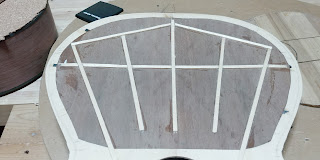20210814
Next is to make the neck, however for the head plate I will need to cut out the back to the plantilla outline.
For that, I used my usual coping saw to do the job.
Hard work? well kind of but it certainly works nicely: controlled and quiet.
20210815
Next step is to prepare the headplate.
First I need to shoot the 2 cut-off straight for jointing.
For the jointing I just use 2 clamps to clamp it tight.
Once the jointed headplate is done, I cut to shape and glue to the head of the neck
20210828
Next I began to work on the head part of the neck, drilling the slots and the tuner holes.
After that I began to shape the head.
At first I was aiming for my new style similar to #11 (haha #11 was build before #10), but the owner prefer something more elaborate.
In the end I settle for a Bouchet style head stock.
It look elegant and have some nice curvess
 Alignment pins for ensuring the template aligns to the head.
Alignment pins for ensuring the template aligns to the head. This portion will be removed during the slots cutting part.
 Drilling tuner holes.
Drilling tuner holes.One of the impt step is to drill the tuner holes before cutting the slot to ensure square alignment of holes.
 Making sure the tuner can slot in correctly.
Making sure the tuner can slot in correctly.A lot of guitar that I have seen doesnt slot in properly because the hole wasn't drill square to the sides.
20210908
Next part is to shape the slot.
I drilled a series of holes (smaller bit diameter than the slots hole).
Then I connect the holes using a coping saw.
The slot is shaped using chisels and finally files and sanding to make it smooth and straight.
20211002
The next part is to work on the heel block.
In my build method, the heel block is build separately from main neck shaft.
Only after the assembly and bindings stage, then the neck is glued to the main body.
THis allows for an cleaner and easier binding process.
That said, it will be crucial that the heel block's geometry structure is compatible with the neck shaft.
So in the building of the heel block, aligning pins are used also.
THe heel block has been glue previously so now is the time to cut the sides slot into the heel block.
To ensure the block is square to the sides, the heel block is placed in the solera with the correct angle and then mark with a square.
Next the slots are marked carefully and cut with a magnetic guide block with the correct angle.
Sides does not insert into the heel block perpendicularly but at an angle and hence the guide block.
The slots are cut using a Japanese ryouba saw and with the guide block.
Waste are chisel out then.
The slots are not parallel but form a wedge shape for wedging the sides tight during assembly.
20211108
Still at the heel block part, next to do is to roughly shape the heel portion.
Need to saw away the heel part to make the shape into a triangle.
This will be last part of processing for the neck.
Subsequent part will be done after assembly.





















































